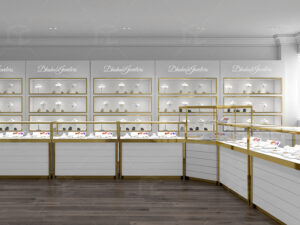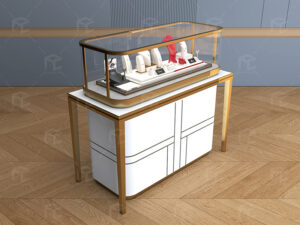
How to Open a Jewelry Store: A Step-by-Step Guide
- By Kang
- December 27, 2023
- 3:42 am
Jewelry is one of the most popular and profitable retail categories, as it appeals to a wide range of customers and occasions.The global jewelry market is expected to grow from about 270 billion U.S. dollars in 2022 to over 330 billion dollars by 2026. Whether you sell fine jewelry or fashion jewelry, handmade jewelry or branded jewelry, you can tap into a huge market of jewelry lovers and buyers.
But how do you open a jewelry store that stands out from the competition and attracts loyal customers? What are the steps and requirements to start and run a successful jewelry business? In this guide, we will walk you through the process of opening a jewelry store, from planning to launching to growing your business.

Step 1: Do Your Market Research
Before you open a jewelry store, you need to do some market research to understand your target market, your competitors, and your industry trends. Market research will help you identify your niche, your unique selling proposition, and your competitive advantage. Some of the questions you should answer are:
– Who are your ideal customers? What are their demographics, preferences, needs, and pain points? How do they shop for jewelry? Where do they hang out online and offline?
– Who are your main competitors? What are their strengths and weaknesses? How do they market and price their products? What are their customer reviews and feedback?
– What are the current and future trends in the jewelry industry? What are the opportunities and threats in the market? How is the industry affected by social, economic, technological, and environmental factors?
According to Statista, the U.S. jewelry market was valued at about 70 billion U.S. dollars in 2021, and the average annual consumer spend on jewelry was more than 136 U.S. dollars¹.
– The most popular product categories in the U.S. jewelry market are diamond jewelry (38.3%), gold jewelry (28.8%), and silver jewelry (19.2%)
Step 2: Write Your Business Plan
After you have done your market research, you need to write your business plan. A business plan is a document that outlines your business goals, strategies, and financial projections. It will help you organize your ideas, test your assumptions, and secure funding and partners. A typical business plan includes the following sections:
– Executive Summary: A brief overview of your business, including your mission, vision, goals, products, target market, competitive advantage, and financial summary.
– Company Description: A detailed description of your business, including your legal structure, ownership, location, history, and team.
– Market Analysis: A summary of your market research, including your industry analysis, customer analysis, and competitor analysis.
– Products and Services: A description of your products and services, including their features, benefits, pricing, and differentiation.
– Marketing and Sales Plan: A description of your marketing and sales strategies, including your positioning, branding, promotion, distribution, and sales channels.
– Financial Plan: A projection of your income statement, balance sheet, cash flow statement, and break-even analysis for the next three to five years.
– Appendix: Any additional information or documents that support your business plan, such as resumes, licenses, permits, contracts, or samples.
Step 3: Secure Your Funding
To open a jewelry store, you will need some startup capital to cover your initial expenses, such as rent, equipment, inventory, insurance, and marketing. Depending on your business size and model, you may need anywhere from $20,000 to $100,000 to get started.
There are several ways to fund your jewelry business, such as:
– Bootstrapping: Using your own savings, assets, or credit cards to finance your business.
– Loans: Borrowing money from banks, credit unions, or online lenders, such as [SBA Loans], [Term Loans], or [Lines of Credit].
– Investors: Pitching your business idea to angel investors, venture capitalists, or family and friends, in exchange for equity or debt.
You should compare the pros and cons of each funding option, and choose the one that best suits your needs and goals. You should also prepare a solid business plan, a pitch deck, and a financial statement to convince potential funders of your business viability and potential.
Step 4: Register Your Business
To open a jewelry store, you will need to register your business with the federal, state, and local authorities. This will make your business legal, protect your personal assets, and allow you to pay taxes and operate in compliance with the law. The steps and requirements to register your business may vary depending on your location and business structure, but they generally include:
– Choosing a business name: You should choose a unique and catchy name for your jewelry store, and check its availability with your state’s business records, federal and state trademark records, social media platforms, and web domain availability. You can use online tools, such as [Business Name Generator], [Trademark Electronic Search System (TESS)], or [Namecheap], to help you with this process.
– Choosing a business structure: You should choose a legal structure for your jewelry business, such as sole proprietorship, partnership, limited liability company (LLC), or corporation. This will affect your personal liability, tax obligations, and management options. You can use online tools, such as [ZenBusiness], [LegalZoom], or [Incfile], to help you with this process.
– Registering your business: You should register your business name and structure with your state’s secretary of state or equivalent agency, and obtain an employer identification number (EIN) from the IRS. You may also need to register with your local county or city clerk, and obtain a sales tax permit, a business license, or a zoning permit, depending on your location and business type. You can use online tools, such as [Business Licenses], [PermitMe], or [FileLocal], to help you with this process.
Step 5: Find a Location and Set Up Your Store
To open a jewelry store, you will need to find a suitable location and set up your store. Your location will affect your visibility, traffic, sales, and costs, so you should choose it carefully. Some of the factors to consider are:
– Your target market: You should choose a location that is close to your ideal customers, and that matches their demographics, preferences, and behaviors. For example, if you sell high-end jewelry, you may want to locate your store in an upscale neighborhood or shopping mall. If you sell trendy jewelry, you may want to locate your store in a hip and fashionable area or street.
– Your competitors: You should choose a location that has a balance between competition and demand. You don’t want to locate your store in an area that is saturated with similar or superior jewelry stores, as you may lose customers and sales. You also don’t want to locate your store in an area that has no or low demand for jewelry, as you may struggle to attract customers and generate revenue.
– Your budget: You should choose a location that fits your budget and cash flow. You don’t want to spend too much on rent, utilities, maintenance, and security, as you may run out of money and go out of business. You also don’t want to compromise on quality, safety, and convenience, as you may lose customers and reputation.
Once you have found your location, you will need to set up your store. This includes:
– Designing your store layout: You should design your store layout in a way that maximizes your space, showcases your products, and enhances your customer experience. You should consider the following elements:
– Entrance: Your entrance should be inviting, attractive, and accessible, and display your business name, logo, and signage.
– Windows: Your windows should be clear, clean, and bright, and display your products, promotions, and messages.
– Lighting: Your lighting should be adequate, appropriate, and adjustable, and highlight your products, create a mood, and facilitate your operations.
– Flooring: Your flooring should be durable, comfortable, and easy to clean, and match your store theme and style.
– Walls: Your walls should be painted, wallpapered, or decorated, and match your store theme and style.
– Furniture: Your furniture should be functional, comfortable, and stylish, and include display cases, shelves, racks, counters, chairs, tables, and mirrors.
– Music: Your music should be pleasant, appropriate, and consistent, and create a mood, enhance your brand, and entertain your customers.
– Temperature: Your temperature should be comfortable, consistent, and adjustable, and suit your products, customers, and staff.
– Security: Your security should be effective, reliable, and discreet, and include locks, alarms, cameras, safes, and guards.
– Purchasing your equipment and supplies: You should purchase the equipment and supplies that you need to run your store, such as:
- Cash register, credit card terminal, receipt printer, barcode scanner, and POS system, to process your transactions and manage your sales.
- Jewelry tools, such as pliers, cutters, tweezers, hammers, files, and soldering iron, to repair, modify, or create your jewelry.
- Jewelry supplies, such as beads, wires, chains, clasps, hooks, and findings, to make your own jewelry or customize your products.
- Jewelry packaging, such as boxes, bags, pouches, tissue paper, and ribbons, to wrap and present your products to your customers.
- Cleaning and polishing products, such as cloths, brushes, solutions, and machines, to keep your products and showcases clean and shiny.
- Office supplies, such as paper, pens, envelopes, stamps, and labels, to handle your paperwork and correspondence.
You can find and compare the best prices and deals for your equipment and supplies online, through platforms such as [Amazon], [eBay], or [AliExpress], or offline, through local suppliers, wholesalers, or distributors.
Conclusion
The cost of opening a jewelry store can vary depending on many factors, but the average cost is between $20,000 and $100,000. However, the cost is not the only factor that determines the success and profitability of a jewelry store. You also need to consider your location, inventory, equipment, marketing, sales, management, and operation, and how to optimize them to reduce your costs and increase your profits. You can find and compare the best prices and deals for your equipment and supplies online, through platforms such as [Amazon], [eBay], or [AliExpress], or offline, through local suppliers, wholesalers, or distributors.
Share:
Table of Contents
Shop Fixtures Manufacturer
We are a manufacturer of display products established in 1995 in Guangzhou, China. We specialize in a wide range of retail store fixtures,including display case,showcase,racks,counters,stands , etc. Providing customers with one-stop merchandising solutions.
Recent Posts
Subscribe to Newsletter
Get all the latest information on shop design ideas, sales and offers. Subscribe to the newsletter:



This Post Has 2 Comments
Pingback: How Much Do Jewelry Store Owners Make? - Penbo Display
Pingback: Latest budget - How Much Does It Cost to Open a Jewelry Store? - Penbo Display
Comments are closed.